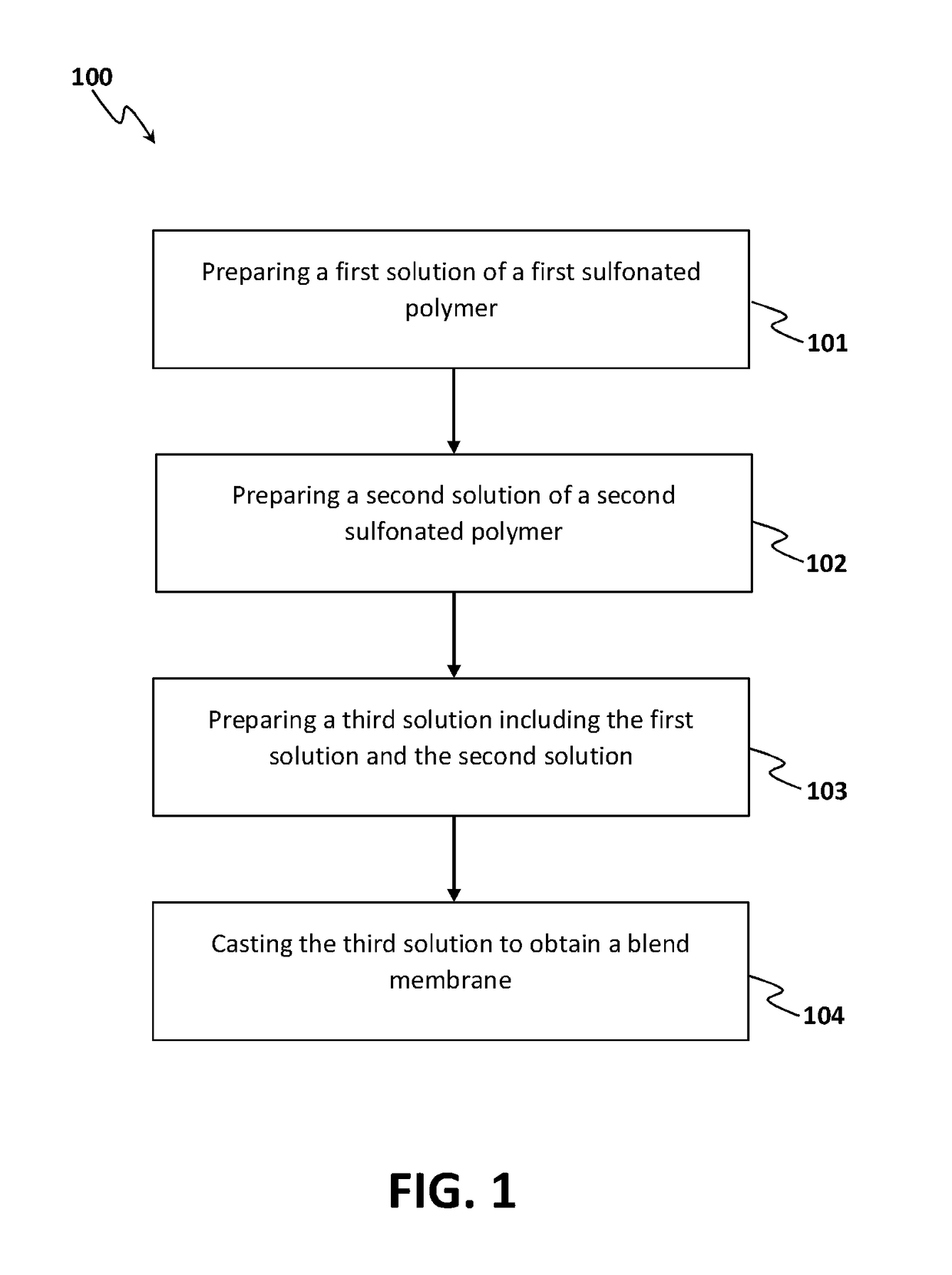Nanocomposite blend membrane
a blend membrane and nanocomposite technology, applied in the field of membranes, can solve the problems of high cost and lack of the required efficiency
- Summary
- Abstract
- Description
- Claims
- Application Information
AI Technical Summary
Benefits of technology
Problems solved by technology
Method used
Image
Examples
example 1
Fabrication of an SPPEK / SPVDF-co-HFP / SWO3 membrane
[0041]In Example 1, an SPPEK / SPVDF-co-HFP / SWO3 membrane was fabricated pursuant to the teachings of the present disclosure. In this case, the SPPEK / SPVDF-co-HFP / SWO3 membrane is composed of sulfonated WO3 nanoparticles (SWO3) and an SPPEK / SPVDF-co-HFP blend polymer.
[0042]For the preparation of WO3 nanoparticles, approximately 10 mL of an ammonia solution with a concentration of approximately 25 wt % was added to a cetyltrimethylammonium bromide (CTAB) solution and stirred to obtain a primary solution. In addition, approximately 0.117 mole of WCl6 was added to approximately 1000 mL of CTAB solution to obtain a secondary solution. The secondary solution was then added to the primary solution to obtain a tertiary solution. The tertiary solution was stirred for about another 4 hours and aged for approximately 72 hours at room temperature. The aged tertiary solution was then filtered and washed with deionized water and ethanol, and calcin...
example 2
Fabrication of an SPPEK / SPVDF-co-HFP Membrane
[0048]In this example, an SPPEK / SPVDF-co-HFP blend membrane is fabricated pursuant to the teachings of the present disclosure. SPPEK was obtained by direct sulfonation of PPEK. In a first step, 2 grams of PPEK powder was slowly added to about 20 milliliters of concentrated sulfuric acid while stirring the solution. The solution was then stirred for another hour at 25° C. After a substantially complete dissolution of PPEK, the solution temperature was raised to 60° C. under a nitrogen atmosphere and continuously stirred for 4 hours, and then cooled to 25° C. The solution was then poured into a large excess of ice water while stirred. The resulting product was washed with deionized water until neutral pH was obtained and dried at 70° C. for about 24 hours in a vacuum oven. The DS of the obtained SPPEK was calculated to be approximately 68% using a titration method.
[0049]Sulfonation of PVDF-co-HFP was conducted in the presence of chlorosulfo...
example 3
Fabrication of an SPPEK Membrane
[0051]In Example 3, SPPEK was obtained by direct sulfonation of PPEK. In a first step, 2 grams of PPEK powder was slowly added to 20 milliliters of concentrated sulfuric acid while stirring the solution. The solution was then stirred for another hour at about 25° C. After complete dissolution of PPEK, the solution temperature was raised to 60° C. under a nitrogen atmosphere, stirred continuously for about 4 hours, and cooled to 25° C. The solution was then poured into a large excess of ice water while stirred. The resulting product was washed with deionized water until neutral pH was obtained and dried at approximately 70° C. for 24 hours in a vacuum oven to obtain an SPPEK membrane. The DS of the obtained SPPEK was calculated to be approximately 68% using titration method. The as-prepared SPPEK membrane is hereinafter referred to as the MS membrane.
PUM
| Property | Measurement | Unit |
|---|---|---|
| proton conductivity | aaaaa | aaaaa |
| tensile strength | aaaaa | aaaaa |
| elongation at break | aaaaa | aaaaa |
Abstract
Description
Claims
Application Information
 Login to View More
Login to View More - R&D
- Intellectual Property
- Life Sciences
- Materials
- Tech Scout
- Unparalleled Data Quality
- Higher Quality Content
- 60% Fewer Hallucinations
Browse by: Latest US Patents, China's latest patents, Technical Efficacy Thesaurus, Application Domain, Technology Topic, Popular Technical Reports.
© 2025 PatSnap. All rights reserved.Legal|Privacy policy|Modern Slavery Act Transparency Statement|Sitemap|About US| Contact US: help@patsnap.com



